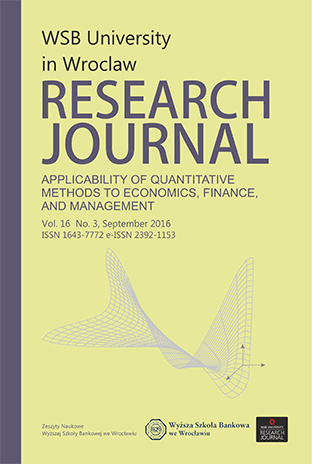Zmiany przestrzennego zróżnicowania poziomu życia ludności w Polsce w latach 2003-2012
DOI:
https://doi.org/10.29015/cerem.260Słowa kluczowe:
poziom życia, analiza przestrzenno-dynamicznaAbstrakt
W opracowaniu przedstawiono wyniki analizy tendencji zmian poziomu życia ludności w Polsce w latach 2003-2012. Przedmiotem przeprowadzonego badania była weryfikacja hipotezy o poprawie oraz malejącym zróżnicowaniu poziomu życia mieszkańców poszczególnych województw w okresie przed i po przystąpieniu Polski do Unii Europejskiej, a także ocena występowania współzależności pomiędzy położeniem zamieszkiwanego województwa a osiąganym poziomem życia. Podstawę analiz stanowiły dane Głównego Urzędu Statystycznego w Warszawie, obejmujące lata 2003 i 2012. W badaniach zastosowano metody statystyczne i ekonometryczne, w tym dynamiczną miarę rozwoju Hellwiga, współczynnik autokorelacji przestrzennej oraz metodę Warda.Z przedstawionych w artykule badań wynika, że w analizowanym okresie we wszystkich województwach kraju nastąpiła poprawa poziomu życia ludności i jednocześnie wzrosła polaryzacja województw pod względem rozważanej kategorii, pojawił się również nowy biegun wzrostu – województwo dolnośląskie.Bibliografia
Bywalec C., Wzrost gospodarczy a poziom życia społeczeństwa polskiego, IRWiK, Warszawa 1991.
Bywalec C., Wydymus S., Poziom życia ludności Polski w porównaniu z krajami EWG, "Ekonomista" nr 5 6, 1992.
Johann M., Polska -UE Porównanie poziomu życia ludności, Difin, Warszawa 2005.
Pluta W., Wielowymiarowa analiza porównawcza w badaniach ekonomicznych. Metody taksonomiczne i analizy czynnikowej, PWE, Warszawa 1977.
Słaby T., Poziom życia, jakość życia, „Wiadomości Statystyczne” 1990, nr 6.
Suchecki H.., Ekonometria przestrzenna Metody i modele analizy danych przestrzennych, Wydawnictwo C.H. Beck, Warszawa 2010.
Śmiłowska T., Zróżnicowanie poziomu i jakości życia ludności w przekroju terytorialnym, Warszawa 1995, z. 229.
Zeliaś A. (red.), Poziom życia w Polsce i krajach Unii Europejskiej, PWE, Warszawa 2004.
Zeliaś A. (red.), Taksonomiczna analiza przestrzennego zróżnicowania poziomu życia w Polsce w ujęciu dynamicznym, Wydawnictwo Akademii Ekonomicznej w Krakowie, Kraków 2000.
Rozporządzenie Rady (WE) nr 1083/2006 z dnia 11 lipca 2006 r. ustanawiające przepisy ogólne dotyczące Europejskiego Funduszu Rozwoju Regionalnego, Europejskiego Funduszu Społecznego oraz Funduszu Spójności i uchylające rozporządzenie (WE) nr 1260/1999 (Dz.U.UE.L.2006.210.25).
http://ec.europa.eu/regional_policy/sources/docgener/informat/country2009/pl_pl.pdf (stan na dzień: 17.08.2015 r.)
http://www.ur.edu.pl/pliki/Zeszyt6/11_Stec_Janas_Kulinski.pdf; M. Stec, A. Janas, A. Kuliński, Grupowanie państw Unii Europejskiej ze względu na zasoby kapitału ludzkiego i intelektualnego, "Nierówności społeczne a wzrost gospodarczy" 6/2005 (stan na dzień: 17.08.2015 r.)
Pobrania
Opublikowane
Numer
Dział
Licencja
Autor przenosi nieodpłatnie na Wyższą Szkołę Bankową we Wrocławiu , bez ograniczeń terytorialnych, majątkowe prawa autorskie do tego utworu w rozumieniu ustawy z dnia 4 lutego 1994 roku o prawie autorskim i prawach pokrewnych ( Dz.U. 1994, Nr 24, poz. 83 ze zm. )na zasadzie wyłączności, tj. prawo do:
a) wyłącznego używania i wykorzystania utworu w dowolnej działalności przez Wyższą Szkołę Bankową we Wrocławiu, w szczególności w działalność Biblioteki Cyfrowej uruchomionej przez Wyższą Szkołę Bankową we Wrocławiu
b) wytwarzania, utrwalania i zwielokrotniania egzemplarzy utworów wszelkimi technikami, w tym techniką drukarską, reprograficzną, zapisu magnetycznego oraz techniką cyfrową, w szczególności ich zwielokrotniania poprzez dokonywanie zapisów na płytach typu CD,
c) zamieszczenia wybranych fragmentów utworu w celach promocyjnych w publikacjach, materiałach promocyjnych, w sieci Internet oraz sieciach wewnętrznych typu Intranet Wyższej Szkoły Bankowej we Wrocławiu,
d) wprowadzania utworu do pamięci komputera Wyższej Szkoły Bankowej we Wrocławiu,
e) kopiowania i powielania utworu w technologiach fotomechanicznych lub innych znanych w dniu zawarcia umowy (fotokopie, kserokopie itp.),
f) przetworzenia dzieła na formę elektroniczną i nieograniczonego rozpowszechniania w sieci Internet.


